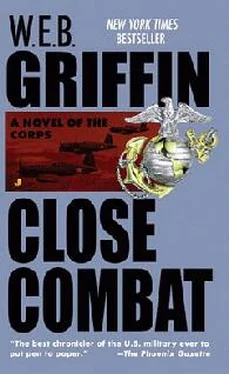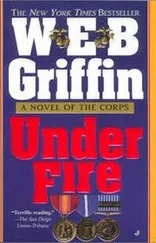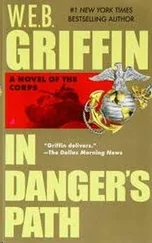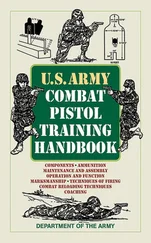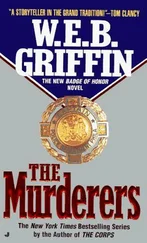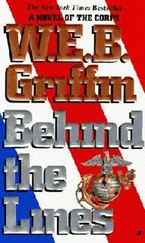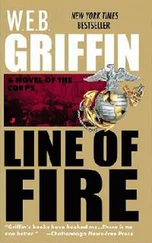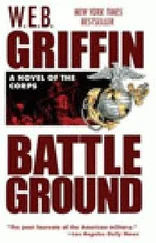W.E.B. Griffin - THE CORPS VI - CLOSE COMBAT
Здесь есть возможность читать онлайн «W.E.B. Griffin - THE CORPS VI - CLOSE COMBAT» весь текст электронной книги совершенно бесплатно (целиком полную версию без сокращений). В некоторых случаях можно слушать аудио, скачать через торрент в формате fb2 и присутствует краткое содержание. Жанр: literature_history, на английском языке. Описание произведения, (предисловие) а так же отзывы посетителей доступны на портале библиотеки ЛибКат.
- Название:THE CORPS VI - CLOSE COMBAT
- Автор:
- Жанр:
- Год:неизвестен
- ISBN:нет данных
- Рейтинг книги:3 / 5. Голосов: 1
-
Избранное:Добавить в избранное
- Отзывы:
-
Ваша оценка:
- 60
- 1
- 2
- 3
- 4
- 5
THE CORPS VI - CLOSE COMBAT: краткое содержание, описание и аннотация
Предлагаем к чтению аннотацию, описание, краткое содержание или предисловие (зависит от того, что написал сам автор книги «THE CORPS VI - CLOSE COMBAT»). Если вы не нашли необходимую информацию о книге — напишите в комментариях, мы постараемся отыскать её.
THE CORPS VI - CLOSE COMBAT — читать онлайн бесплатно полную книгу (весь текст) целиком
Ниже представлен текст книги, разбитый по страницам. Система сохранения места последней прочитанной страницы, позволяет с удобством читать онлайн бесплатно книгу «THE CORPS VI - CLOSE COMBAT», без необходимости каждый раз заново искать на чём Вы остановились. Поставьте закладку, и сможете в любой момент перейти на страницу, на которой закончили чтение.
Интервал:
Закладка:

Griffin, W.E.B.
THE CORPS VI - CLOSE COMBAT
THE CORPS is respectfully dedicated to the memory of Second Lieutenant Drew James Barrett, III, USMC Company K, 3d Battalion, 26th Marines Born Denver, Colorado, 3 January 1945 Died Quang Nam Province, Republic of Vietnam, 27 February 1969 and Major Alfred Lee Butler, III, USMC Headquarters 22nd Marine Amphibious Unit Born Washington, D.C., 4 September 1950 Died Beirut, Lebanon, 8 February 1984 "Semper Fi!" And to the memory of Donald L. Schomp A Marine fighter pilot who became a legendary U.S. Army Master Aviator RIP 9 April 1989
[ONE]
Henderson Field
Guadalcanal, Solomon Islands
0515 Hours 11 October 1942
First Lieutenant William Charles Dunn, USMCR, glanced up at the Pagoda through the scarred Plexiglas windshield of his battered, mud-splattered, bullet-holed Grumman F4F4 Wildcat. The Henderson Field control tower didn't look like a pagoda, but Dunn had never heard the Japanese-built, three-story frame building called anything else.
A tanned, bare-chested Marine stepped onto the narrow balcony of the Pagoda, pointed his signal lamp at the Wildcat on the threshold of the runway, and flashed Dunn a green.
Captain Bruce Strongheart, fearless commanding officer of the Fighting Aces Squadron, carefully adjusted his silk scarf and then nodded curtly to Sergeant Archie O'Malley, his happy-go-lucky, faithful crew chief O'Malley saluted crisply, and Captain Strongheart returned it just as crisply. Then, adjusting his goggles over his steel-blue eyes, his chin set firmly, not a hair of his mustache out of place, he pushed the throttle forward. His Spad soared off the runway into the blue. Captain Strongheart hoped that today was the day he would finally meet the Blue Baron in mortal aerial combat. The Blue Baron, Baron Eric von Hassenfeffer, was the greatest of all German aces. With a little bit of luck, he would shoot down the Blue Baron (in a fair fight, of course) and be back at the aerodrome in time to share a champagne luncheon with Nurse Helen Nightingale.
Dunn was twenty-one years old. He hadn't shaved in two days, or had a shower in three. He was wearing: a sweat-stained cloth flight helmet, with the strap unbuckled and the goggles resting on his forehead; an oil- and sweat-stained cotton Suit, Flying, Tropical Climates; a T-shirt with a torn collar; a pair of boxer shorts held in place with a safety pin (the elastic band had long ago collapsed); ankle-high boots known as "boondockers"; and a.45 Colt automatic in a shoulder holster.
Dunn, who was (Acting) Commanding Officer of USMC Fighter Squadron VMF-229, looked around to check whether all of his subordinates had made it out of the revetments to the taxi strip, or to the runway. There was a Wildcat on the runway, sitting almost parallel with him (First Lieutenant Ted Knowles, who had arrived from Espiritu Santo four days before). Five more Wildcats were on the taxiway.
Seven in all, representing one hundred percent of the available aircraft of VMF-229, were prepared to soar off into the wild blue. According to the table of organization and equipment, VMF-229 should have had fourteen F4F4s.
Dunn then looked at his faithful crew chief, Corporal Anthony Florentino, USMC-three weeks older than he was. Florentino had developed the annoying habit of crossing the taxiway and standing at the side of the runway to bid his commanding officer farewell. When Dunn's eyes caught his, he smiled and made a thumbs-up gesture.
I wish to Christ he wouldn't do that.
Tony Florentino had large expressive eyes; it wasn't hard for Dunn to see what he was thinking: This time the Lieutenant's not coming back.
He's not questioning my flying skill, Dunn was aware, but he knows the laws of probability. Of the original sixteen pilots who came to Guadalcanal with VMF-229, only two are left-me and the Skipper, Captain Charles M. Galloway. Of the twenty-two replacement pilots flown in from Espiritu Santo, only nine remain.
You can't reasonably expect to go up day after day after day and expect to survive-not against enemies who not only outnumber you, but are flying, with far greater experience, the Zero, a fighter plane that is faster and more agile than the Wildcat.
Dunn glanced at Ted Knowles and nodded, signaling that he was about to take off. Then he looked at Tony Florentino again and made an OK sign with his left hand. After that he took the brakes off and pushed the throttle forward. .
For Christ's sake, Tony, please don't do that Catholic crossing-your-self-in-the-presence-of-death crap until Fm out of sight.
Lieutenant Dunn, glancing back, saw that Lieutenant Knowles was beginning his takeoff roll. Then he saw Corporal Florentino crossing himself.
He dropped his eyes to the manifold pressure gauge. He was pulling about thirty inches. The airspeed indicator jumped to life, showing an indicated sixty knots. He was pulling just over forty inches of manifold pressure when he felt the Wildcat lift into the air.
He took his right hand from the stick and grabbed the stick with the left. Then he put his free hand on the landing-gear crank to his right and started to wind it up. It took twenty-eight turns. The last dozen or so, as the wheels moved into their final stowed position, were hard turns. When he was finished, he was sweating.
Dunn put his right hand back on the stick and headed out over the water. In the corner of his eye, he saw Knowles slightly behind him.
When he was clear of the beach, he reached down and grabbed, in turn, each of the four charging handles for the.50 caliber Browning machine guns (these were mounted two to a wing). He reached up and flipped the protective cover from the GUNS master switch, then pulled on the stick-mounted trigger switch.
All guns fired. He was not surprised. VMF-229 had the best mechanics at Henderson. And these were under the supervision of Technical Sergeant Big Steve Oblensky, who'd been a Flying Sergeant when Bill Dunn was in kindergarten. Another Old Breed Marine, Gunnery Sergeant Ernie Zimmerman, took care of the weapons. Dunn was convinced that Zimmerman knew more about Browning machine guns than Mr. Browning did.
But he would not have been surprised either if there had been a hang-up... or two hang-ups, or four. This was the Cactus Air Force (from the code name in the Operations Order) of Guadalcanal, located on a tropical island where the humidity was suffocating, the mud pools were vast, and the population of insects of all sizes was awesome. Their airplanes were in large part made up of parts from other (crashed, bombed, or shot down) airplanes, and were subjected to daily stresses beyond the imaginations of their designers and builders. Flying them was more an art than a science. That anything worked at all was a minor miracle.
Reasonably sure that by now the rest of the flight was airborne, Dunn picked up his microphone and pressed the switch.
"Check your guns," he ordered. "Then check in."
It was not the correct radio procedure. Marine flight instructors back in the States would not have been pleased. Neither, for that matter, would commanding officers back at Ewa in Hawaii, or probably even at Espiritu Santo. But there was no one here to complain. Those addressed knew who was speaking, and what was required of them.
In the next few minutes, one by one, they checked in.
"Two, Skipper, I'm OK."
That was Knowles, on his wing. "Seven, Sir, weaponry operable."
One of the new kids, thought twenty-one-year-old Bill Dunn, yet to be corrupted by our shamefully informal behavior.
"Three, Skipper."
Читать дальшеИнтервал:
Закладка:
Похожие книги на «THE CORPS VI - CLOSE COMBAT»
Представляем Вашему вниманию похожие книги на «THE CORPS VI - CLOSE COMBAT» списком для выбора. Мы отобрали схожую по названию и смыслу литературу в надежде предоставить читателям больше вариантов отыскать новые, интересные, ещё непрочитанные произведения.
Обсуждение, отзывы о книге «THE CORPS VI - CLOSE COMBAT» и просто собственные мнения читателей. Оставьте ваши комментарии, напишите, что Вы думаете о произведении, его смысле или главных героях. Укажите что конкретно понравилось, а что нет, и почему Вы так считаете.
